1963
The bad weather of January 1963 perhaps prompted Gateshead to use two of its English Electric Type 3s and Peak D177 on freights to Consett, the first time either class had been to Consett, both proved capable of handling the route, being able to handle a double load of eighteen loaded 21ton hoppers from South Pelaw to Consett, and doing so un-assisted.
1964
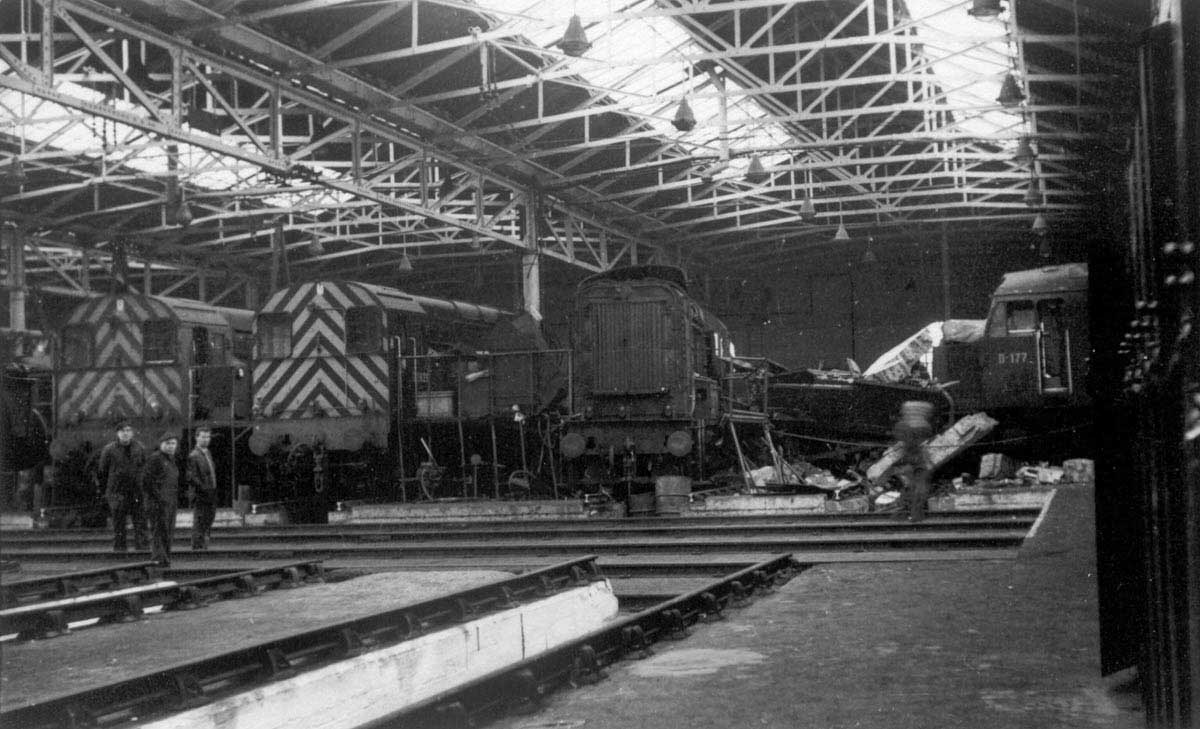


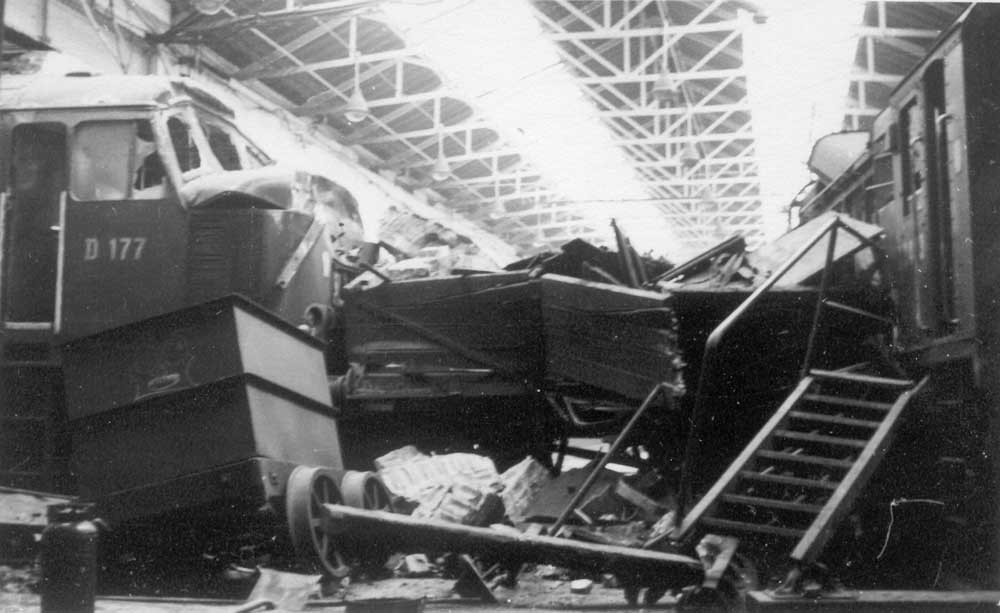
1966

1967
On July 28th Clapham Junction witnessed the failure of D117 whilst working the Stirling - Newhaven car-sleeper. It stalled across the main lines, a station pilot dragged the train back into the station, the Peak being replaced by E6004, a delay of two hours having been created. The return working used an electric locomotive to Three Bridges where an LMR diesel was waiting to take over. From time to time the Peaks laying over at Newhaven would be used on local trip workings, with D60 so noted on August 18th working a trip to Norwood.
In 1965 a refurbishment programme commenced for the Class 46's, a similar programme for the Class 45's began during June 1967 and the first locomotive treated was D60. The programme included over two hundred internal & external modifications intended to improve their reliability. Due to the cost only the early examples received for refurbishment received all the modifications.
Some of the obvious alterations included:
Fitting the later style single panel headcode
Replacement of the lower bodyside panel for a louvred panel
Nose end grilles were changed from fixed aluminium to hinged steel with latches
Six inch handrails were added to the nose inboard of the marker lights
The vertical boiler room grille was plated over
Roof filling hatches and the steps/handholds to the filler were plated over
Other less obvious changes included
Installation of bodyside filters throughout the engine room
Division of the engine room roof between the main section and the exhaust silencer
Air reservoirs moved from the No.2 nose end to allow for later installation of the compressor for train airbrake equipment
Triplex gold laminated windscreens fitted in place of the double glazed type, & now demister equipped
Improved windscreen wiper motors fitted, windscreen washers installed
As is well reported elsewhere the Sulzer 12LDA28B power unit also received numerous improvements to strengthen the engine and to correct problems brought to light since first entering service in 1960. Traction motors also received new armature shafts, a different gade of carbon brushes were installed along with new brush springs. Lubrication for the axleboxes and bogies was changed from oil to grease, the segmental bearing filler points were plated over.
And presumably for D60 this is when it received its blue livery.
1969
Since the arrival of the Peaks at Holbeck they had been increasingly used on the named Thames-Clyde and Waverley passenger trains as well as other daytime and sleeper services over these Anglo-Scottish routes. When the much delayed closure of the Carlisle - Edinburgh 'Waverley' route finally occurred early in 1969 the Peaks were still front line power for the passenger services and it would be left for one of them to handle the last Up Waverley.
It was therefore no surprise to find 60 'Lytham St Annes' diagrammed for the last scheduled train, the 1M82 21.56 Edinburgh - St. Pancras, with eight coaches and two sleepers. Carlisle was reached over two hours late caused by the boisterous activities of many local people protesting the closure of the route. The Hawick pilot, 8606, was sent ahead light engine to ensure the integrity of the line south of Hawick. A light snow fall had taken place during the day, but the evening saw clearing allowing the sun to set one last time on this run and providing the protesters with a chilly night out.
The four views below, courtesy of Bruce McCartney show the late evening arrival of the last Up Waverley at Hawick with its attendant crowd of passengers and those protesting the closure of the route.
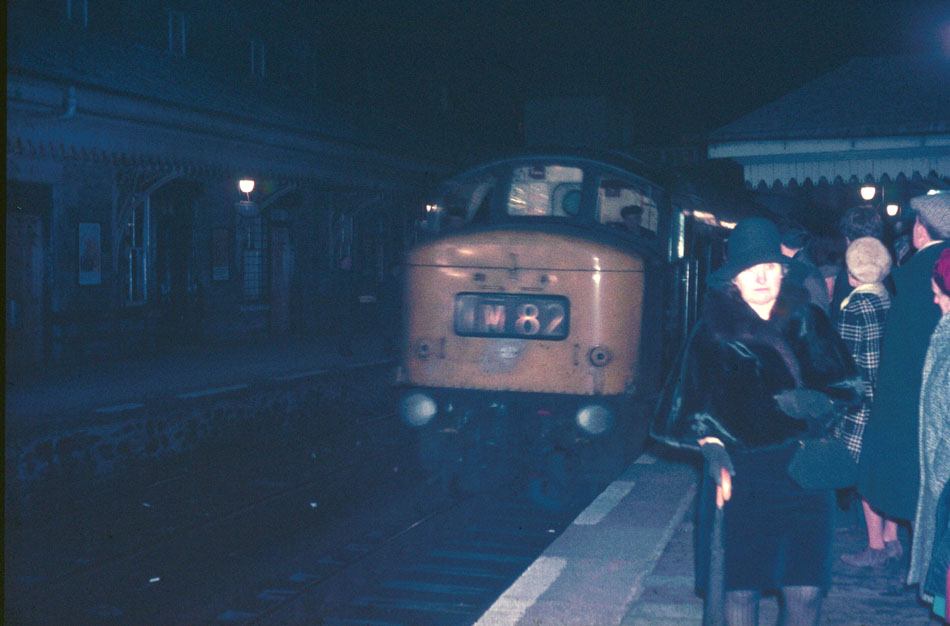
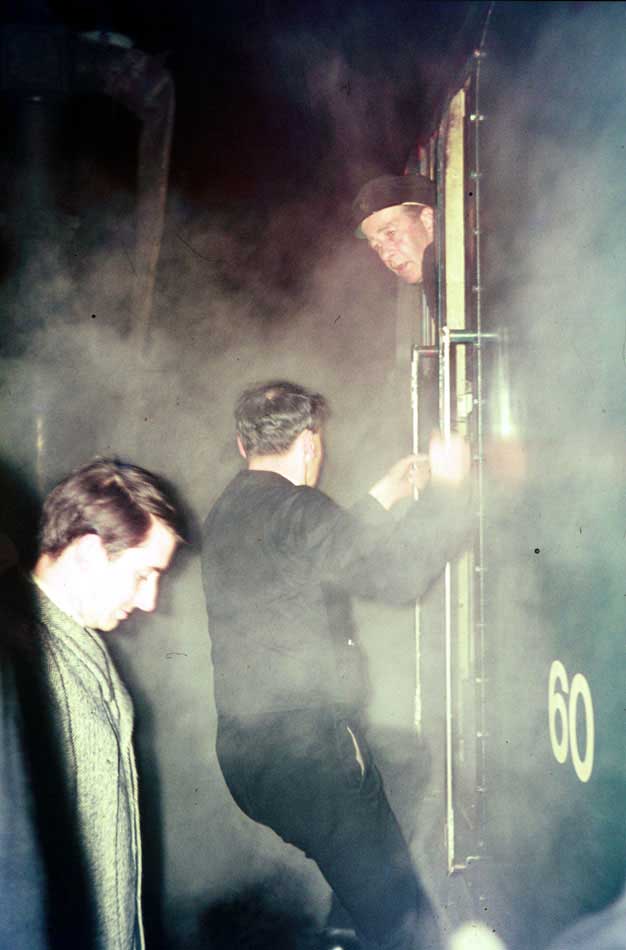

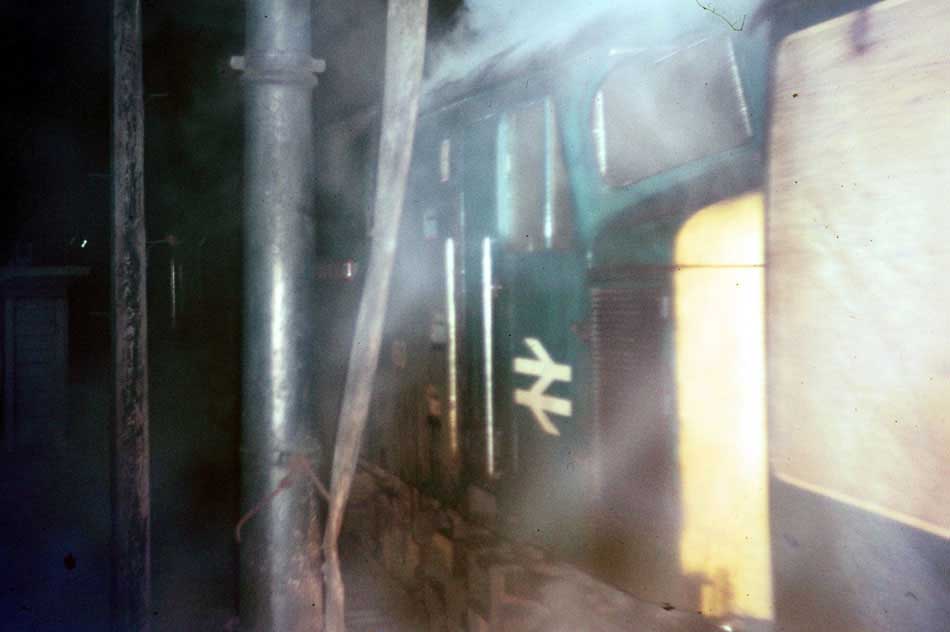
(Additional notes for the above views)
To answer the question posed in the second view above - it is the Hawick signalman, Gordon Hall, stepping down from the cab of the Peak, he has just given the driver verbal instructions to pass the Home signal at Hawick at danger under the "section clear, but station or junction blocked" regulation, because the pilot locomotive, sent ahead, was still in the section. Signalman Hall had changed shifts to be on duty in order to be able to pull the signal for the last train to leave, which he was not able to do, since the Up Waverley would depart under his verbal instruction.
After originally posting the views above further information has come to light surrounding the events of that chilly night. The second view features driver Fleming at the controls of the Up Waverley, out of view is fireman Patterson, both of Haymarket depot. The driver is in the process of receiving verbal instructions to proceed southward, neccessary due to the unruly activities of people further south, particularly in the vicinity of Newcastleton. The gentleman facing the locomotive and staring downwards is none other than David Steel, MP, who would eventually join the train. The Up Waverley had arrived at Hawick at 23.27 and left fractionally after midnight. It was preceded by the Hawick pilot, Clayton Type 1 D8606 in charge of Hawick driver Wylie accompanied by Relief Supervisor Jones and some Permanent Way staff.
The pilot had left Hawick just prior to the arrival of the Up Waverley, proceeding south to inspect the line. It reached Newcastleton safely shortly before midnight, having exploded a good quantity of detonators en-route. With this section of the route considered safe the Up Waverley was allowed to enter the section eventually catching up with the Hawick pilot at Newcastleton where an unruly crowd of about forty villagers had gathered and blocked the line.
At Newcastleton trouble had been brewing for a while. Persons unknown had chained the level crossing gates shut, however the gates were quickly released from this impediment by local Permanent Way staff. A large crowd had gathered intent on ensuring that the level crossing gates remained closed to rail traffic. In this process vandalism occurred and the gates were damaged, the local church minister, Mr Maben taking a significant part in leading the 'uprising'. A Landrover used by a BR Traffic Inspector was commandeered and placed in the middle of the level crossing. With the situation becoming more unruly a large police contingent was summonsed to deal with the crowd, now estimated at some two hundred villagers.
Scuffling broke out when the first police arrived, the Landrover was removed from the level crossing but the police were less successful in clearing the crowd from the level crossing. Whilst all this was taking place Clayton 8606 had been sitting a short distance away from the level crossing. The Up Waverley arrived at the Newcastleton home signal at about 00.45, here David Steel, MP alighted to try and assist with a diplomatic dispersal of the large crowd. His attempts were met by equal rhetoric from minister Maben, who was soon 'escorted' away by the police, leading to the crowd becoming evening more threatening.
Further police arrived to protect the train, a second address to the crowd by Mr Steel and the release of minister Maben without charges being pressed led to the crowd taking on a more peaceable atmosphere, such that the police were then able to clear the level crossing and assist the railway staff in opening the gates to rail traffic. Just after 01.30 the pilot headed south towards Kershopefoot. In attempting to draw clear of the crossing it was found that the hose pipe on the last vehicle of the Up Waverley (BG 80834) had been cut, destroying any vacuum the locomotive was trying to create. The brakes on the vehicle were isolated and the train drew forward only to have the communication chord pulled midway over the level crossing! This was soon corrected and with word received that the pilot had reached Kershopefoot safely the Up Waverley departed Newcastleton at 01.50. Five minutes later the Traffic Inspector was dropped off at Kershopefoot, the section through to Longtown was travelled under caution, clearing Longtown at 02.13 without incident.
The pilot returned north from Newcastleton reaching Hawick shortly after 02.30.
1979
March 1st started like many other days, just routine, the humdrum of daily life caught up in the details, with many things swiftly forgotten as time rolled on by. For three railwaymen assigned to Cardiff depot it was just routine, for the guard it was that of booking on at 6.00am to prepare the stock for the 07.40 Cardiff - Newcastle, a total of ten coaches including a restaurant vehicle and a BG. This day the train locomotive, 46036 arrived about 6.45am and a brake continuity test was carried out. This tested satisfactory and the guard joined the two railmen in the locomotive cab for the short run up to Cardiff General station.
The train departed on time at 7.40am, with the guard having taken up his regular duties in the train. The train remained on time at Newport and was routed along the north bank of the Severn Estuary towards Chepstow and Gloucester. Approaching Chepstow the guard moved to the front of the train to begin collecting tickets and had worked back as far as the third vehicle, the buffet car when the normality of this day came to a sudden and dramatic halt.
A sudden and violent impact threw the guard to the floor, briefly disorientating him and requesting a passenger to look out of the window of the now stationary train to see what might be amiss. In the second coach were two railmen riding 'on the cushions' to Gloucester, once the train had stopped they ran forward to the locomotive. All was quiet, the engine had shut down, no doubt a result of the severe damage sustained to the leading cab of 46036, tragically it was obvious to the two railmen that they could be of no assistance to the crew of 46036. From the rear cab protection equipment was obtained to isolate the track circuit on the down line whilst the locomotive's battery was isolated.
Calls were made from the signal telephone to notify Newport powerbox of the disabled train, which itself was not derailed, but whatever it had hit at Naas Crossing was now fouling the down line. Other rail staff also travelling on the train provided protection to the rear and assistance to the guard.
What had appeared to be just another routine run ended when the train hit an eight-wheel Scammell Routeman lorry equipped with a specially designed body used for hauling waste in either 30 cubic yard or 40 cubic yard skips. In this case it was the smaller but fully loaded skip, with a combined weight of about 12.50 tons. It was this part of the lorry that caused so much damage to the locomotive, during the collision the skip parted company from the lorry cab & chassis, the latter were tossed clear of the tracks about thirty yards down from the crossing, the skip ended up on the down line about one hundred yards from the crossing, beyond this point the train coasted for a further third of a mile before stopping. Regretably the lorry driver also perished in the collision.
The Department of Transport accident report placed the cause of the accident to be the failure of the lorry driver driver to follow the operating procedures for the use of Naas crossing.

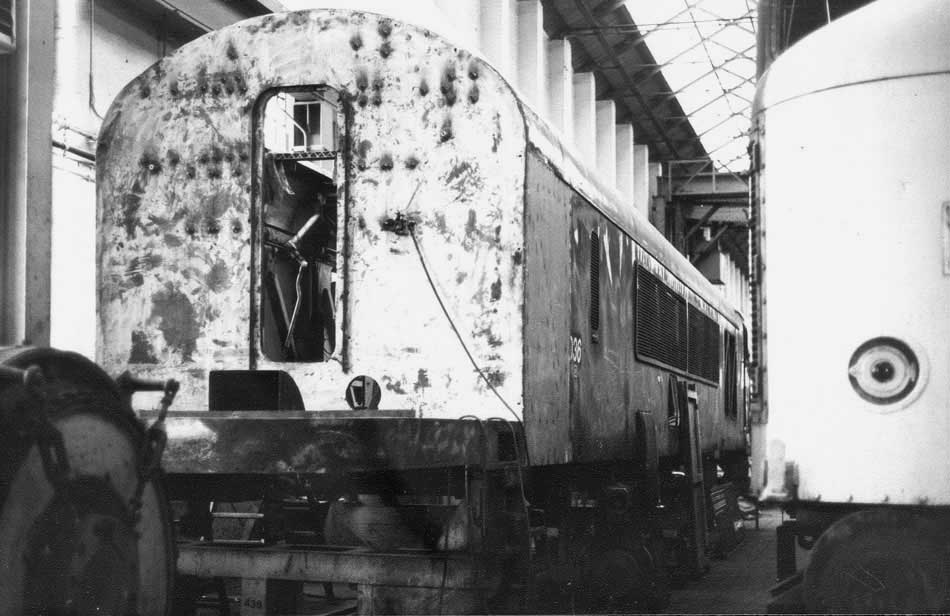
1987
During July Tinsley started to apply painted names to the remaining Class 45's. On August 18th 45106 was noted named 'Vulcan'.
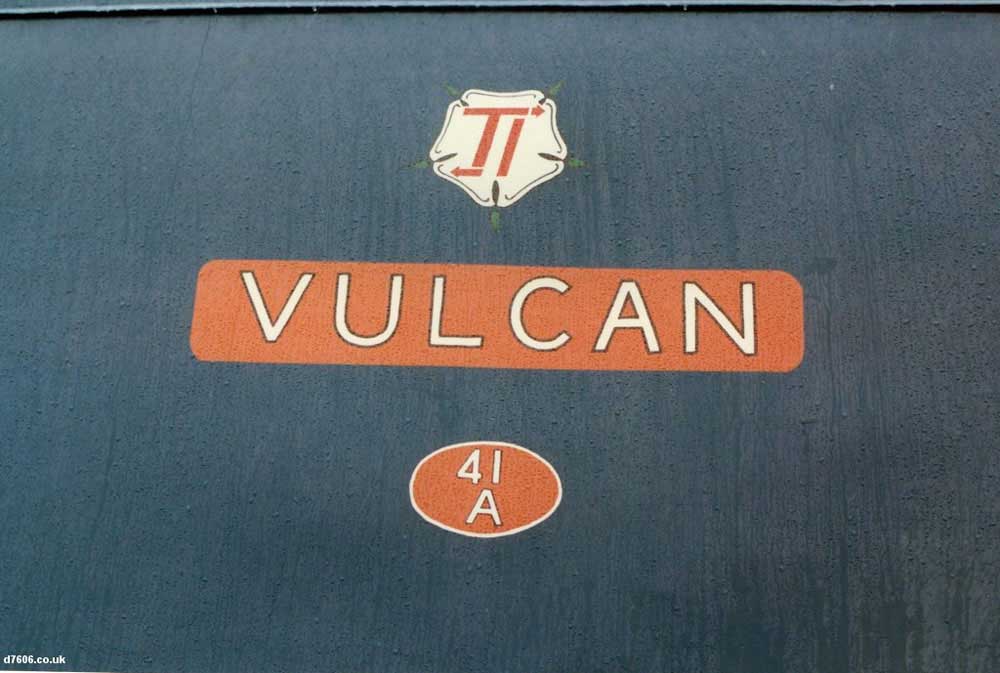
45022 was withdrawn during July in working order but would live to fight another day, being one of several Peaks reinstated during September to assist with the engineering work involved with electrification of the northern end of the ECML. 45022 was renumbered 97409 for this purpose.

1989

On February 3rd 45106 failed whilst working the 07:12 Derby - St. Pancras at Wellingborough, it was rescued by 97472, but then caught fire near Hendon. Withdrawal, not unexpected with the damage sustained came on February 20th 1989.
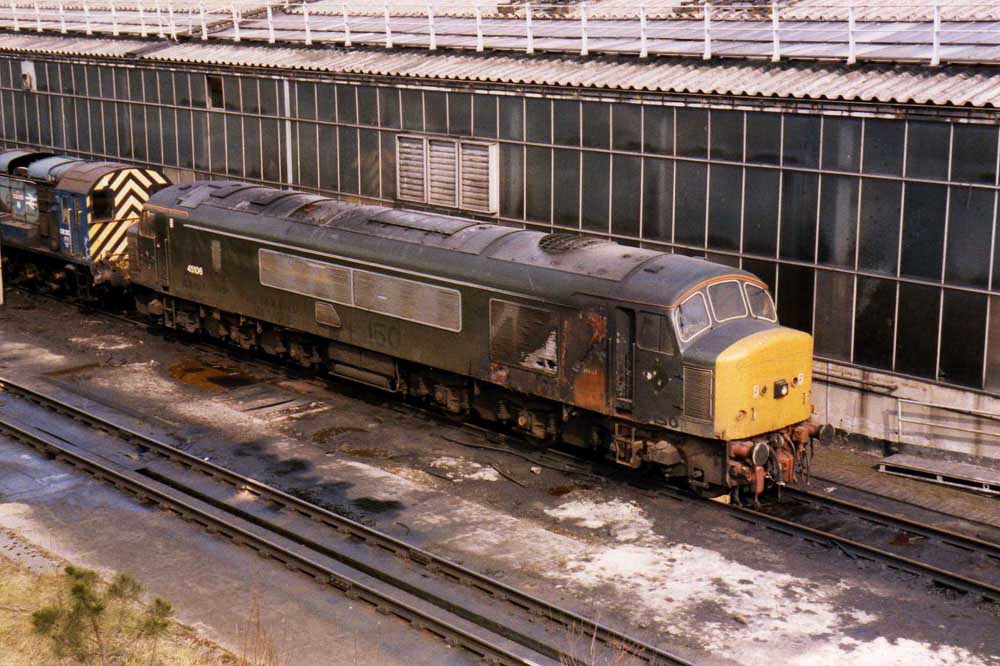
The withdrawn 45106 eventually returned north to Tinsley, lingering at the depot until shipped off to Booth's Rotherham and broken up there during April 1992.
1994
45143 also ended its days at MC Metals, Glasgow, broken up during March.
![]()
![]()
May 5th 1979 & beyond
An overcast day at Derby during May 1979 that began a journey which is still not yet completed. After many recent weekends of travelling on day excursions to many points of the country May 5th proved to be a lot simpler, time spent at Derby station prior to a late morning visit to Derby Locomotive Works.
The Locomotive Works was its usual self, meeting up with the tour organiser, names called off, a head count and then through the gate to follow the well heeled route taken many times. The usual variety of locomotives was recorded in many a notebook, of Classes 08/20/25/45/46. One of the locomotives that drew considerable attention was 46036. It had arrived recently with its damaged cab tarpaulined over, but on this visit the tarpaulin was gone and the full extent of the damage was there for all to see. Not that such a scene was unusual, Derby (and the other BREL Workshops) always seemed to have locomotives on hand that had met with unfortunate circumstances.
But this day was a little different, I was at the back of the party, which had stopped close by 46036 and as one of my cameras was out of film I chose this brief stop to change out the film. With the new film in the camera I ran off a couple of shots to make sure the film had taken up properly on the spool.
Something however provoked a thought, the object before me was where two railwaymen going about their normal duties had perished. An odd thought, after all the carnage on our roads with the frequent graphic photographs splashed across our newspapers and TV footage featuring all too frequently on our news programs was nothing new. And as a frequent visitor to a variety of locomotive workshops the sight of collision damaged rolling stock was something that one came to expect. But my conscience was troubled...........perhaps it was a realisation of my own mortality, not something which I'd given much thought up to this point.
And after the question of mortality comes the question of life itself, what am I doing here, is life meaningless, without apparent purpose or is their a plan? At that point in time I couldn't have honestly answered any of those questions, but what I know now is that God was knocking at my door. It would take another ten years or so to find the truth, to realise the all of this is not an accident, that God does exist and that Jesus Christ, His only Son came to earth to provide the means for Salvation for us.
I make no apology for using this page to profess the truth that is Jesus Christ, it has to be this page because God used something I loved, my interest in railways to bring me to Him.
We don't all get dramatic visitations from God such as happened to Paul on the road to Damascus, God will use whatever He can do draw us near.
If you hear Him knocking, please open the door!!
Page added July 30th 2022.